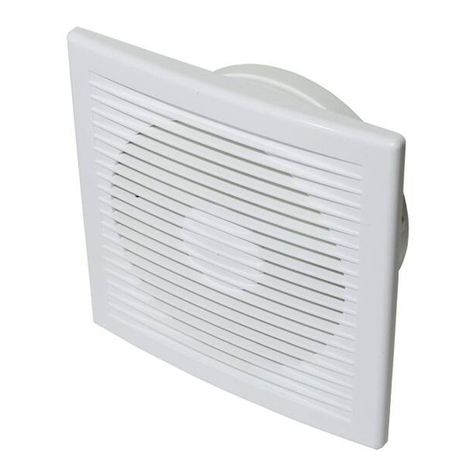
Step 3: LAYING OUT THE INSULATED DUCTING
Do not cut the insulated ducting, if it is too long try to mount the blower unit or outlet vents to accommodate the full length or spread the ducting out
in a large loop. Ensure there are no kinks, or tight bends – support (by suspending) if needed.
Step 4: INSTALLING THE MAIN FAN UNIT
Keep the main fan unit away from the bedroom area to keep any possible noise to a minimum.
The main blower unit is mounted by suspending it on the single chain provided.
Ensure the unit is not touching anything in the ceiling cavity as this may cause noise or vibration when the unit is running.
The main blower unit needs to be mounted as high as possible (check the control cable and ducting will reach prior to mounting) in the roof cavity,
as this will allow it to collect the warmest air in heat recovery mode.
Use the included 200mm wire securing ring in addition to the provided duct tape to ensure the permanent fitting of the ducting to the main blower
unit.
Step 5: FITTING OF FILTER BAGS (FV82)
The filter bags (FV82) are a tight fit and will need to be stretched over the bag holder ring; the Velcro tabs will hold the bags in place.
Step 6: MAINS SUPPLY TO FAN UNIT
A power outlet needs to be installed by a registered electrical contractor in the ceiling next to the fan unit, and the unit plugged in using the supplied
power cable and plug.
Any modifications to, or removal of this power cable will invalidate the warranty.
This unit contains sensitive electronic components that will be damaged by incorrect electrical installation.
Step 7: INSTALLATION OF CONTROL PAD
The included control pad and flush box should be installed by one of the outlet vents in the hallway (or stairwell) of your home.
Run the supplied 5metre control cable (with the push in connections on both ends) down the wall, this needs to be first plugged into the main unit,
and then into the control pad. DO NOT cut, shorten, modify, or use any other cable – surplus control cable should be left in the ceiling cavity.
*Modification of the control cable will invalidate the warranty.
There is no designated end to the control cable (i.e. either end can be plugged in at either connection).
ENSURE THE CONTROL PAD IS NOT IN DIRECT SUNLIGHT, OR NEAR A HEAT SOURCE SUCH AS A PANEL HEATER AS THE CONTROL
PAD CONTAINS A TEMPERATURE SENSOR.
Note: The control cable supplied to connect the unit to the control pad should be kept as far away from mains voltage cables, light cable, power
cables etc as possible and NOT coiled up.
Step 8 (Optional): DUCT TEMPERING UNIT
A separate Duct tempering unit (FH800) can be purchased to work in conjunction with your Weiss Home Ventilation System. The duct warming unit
is used to warm incoming air to your home on cool winter nights. This unit contains a 1,000-watt element and is controlled electronically from your
Home Ventilation System; the heater temperature is based on your ceiling cavity temperature, and the program setting you have selected
(see section 4).
Step 9 (Optional): INSTALLATION OF DUCT TEMPERING UNIT (FH800 – Optional Extra)
To install a duct tempering unit, the power must be completely disconnected from the entire Weiss Home Ventilation system, The Duct tempering
unit needs to be fitted as close as possible to the main blower unit (less than 300mm).
PROGRAMMING AND CONTROL
FIRST POWER UP OF THE SYSTEM
Connect the main power and control cable. The order of these connections is not important. The ventilation system will automatically start when all
connections are completed. It will then take 20 seconds for the system to start, following this the On / Off LED will blink for approximately 2 minutes
as the system initialises.
When initialising is complete the auto/manual LED will illuminate, the program LED will illuminate and the bottom Speed button will illuminate. The
system will now be running in auto program 1.
The system will then continue to run in automatic mode in the default program (System Setting 1).
If this setting does not suit your house size, i.e. less than 100m2ensure the system is in automatic mode (indicated by the Manual / Auto LED being
on) and then use the ‘speed’ up / down buttons to select another program that suits your home size, from the program chart. Make sure the LED
light pattern matches the setting you require.
The settings can be changed rapidly at any time and become the default setting 1 hour after the change has been made.
Always leave the unit turned on. If your house is over approximately 22 degrees the system will go to Standby mode and wait until the temperature
drops, when it will restart again.
For Systems fitted with a duct tempering unit
The winter button turns the duct warmer on and off and will illuminate when pressed but will not turn the warmer on until the temperature in the
ceiling drops below 13.
The duct tempering unit is always controlled by a microprocessor located in the main unit and the programme you have selected
RECOMMENDED SETTINGS
FOR FV802 – Dual Outlet Home Ventilation System ONLY – (Without a Duct Tempering Unit):
© Weiss (NZ) Limited 2005 Weiss (NZ) Limited reserves the right to alter designs and specifications without notice. R02:1110708
INSHVS






















